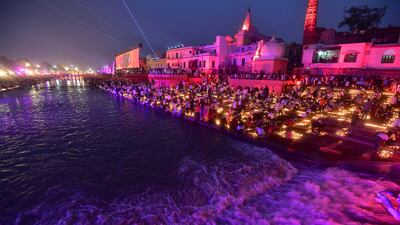Millions of Indians celebrated Diwali on Sunday, setting a Guinness World Record for the number of bright earthen oil lamps, as concerns about air pollution soared in the country.
Across the country, dazzling multi-colored lights decked homes and streets as devotees celebrated the annual Hindu festival of light symbolizing the victory of light over darkness.
But the spectacular and long-awaited lighting of the oil lamps took place as usual on the banks of the Saryu river in Ayodhya, the birthplace of the Hindu deity Rama.
At dusk on Saturday, devotees lit more than 2.22 million lamps and kept them burning for 45 minutes as religious hymns filled the air at the banks of the river, setting a new world record. Last year, more than 1.5 million earthen lamps were lit.
After counting the lamps, Guinness World Records representatives presented a certificate to Uttar Pradesh state’s top elected official, Yogi Adityanath.
More than 24,000 volunteers, mostly college students, helped prepare for the new record, said Pratibha Goyal, vice chancellor of Dr Ram Manohar Lohia Avadh University in Ayodhya.
Diwali, a national holiday across India, is celebrated by socialising and exchanging gifts with family and friends. Many light earthen oil lamps or candles as fireworks are set off as part of the celebrations.

In the evening, a prayer is dedicated to the Hindu deity Lakshmi, who is believed to bring luck and prosperity.
Over the weekend, authorities ran extra trains to accommodate the huge numbers trying to reach their home towns to join in family celebrations.
Air quality concerns
The festival came amid rising worries about air quality in India.
A “hazardous” 400-500 level was recorded on the air quality index last week, more than 10 times the global safety threshold, which can cause acute and chronic bronchitis and asthma attacks.
But on Saturday, unexpected rain and a strong wind improved the levels to 220, according to the government-run Central Pollution Control Board.

Air pollution levels are expected to soar again after the celebrations end on Sunday night because of the fireworks used.
Last week, officials in New Delhi shut down primary schools and banned polluting vehicles and construction work in an attempt to reduce the worst haze and smog of the season, which has posed respiratory problems for people and enveloped monuments and high-rise buildings in and around India’s capital.
Authorities used water sprinklers and anti-smog guns to control the haze and many people used masks to escape the air pollution.
Almost every year, New Delhi is named as India's city with the worst air quality, particularly in the winter, when the burning of crop residues in neighbouring states coincides with cooler temperatures that trap deadly smoke.
Some Indian states have banned the sale of fireworks and imposed other restrictions to stem the pollution. Authorities have also urged residents to light “green crackers” that emit less pollutants than normal fireworks. But similar bans have often been disregarded in the past.
This year's Diwali celebrations took place as authorities prepared for the January opening of a temple to Rama at former the site of the 16th-century Babri mosque in Ayodhya.
The mosque was destroyed by a Hindu mob with pickaxes and crowbars in December 1992, sparking violence between Hindus and Muslims that left about 2,000 people dead, most of them Muslims. The Supreme Court’s verdict in 2019 allowed a temple to be built in place of the demolished mosque.








